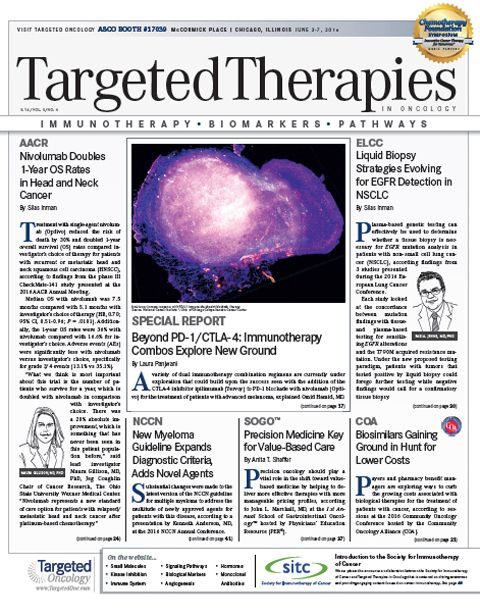Neoadjuvant T-VEC Topic of Phase II Melanoma Study
A phase II study is exploring the oncolytic virus talimogene laherparepvec (T-VEC; Imlygic) in the neoadjuvant setting for patients with resectable melanoma.
Robert H.I. Andtbacka, MD
A phase II study is exploring the oncolytic virus talimogene laherparepvec (T-VEC; Imlygic) in the neoadjuvant setting for patients with resectable melanoma, representing a continued trend toward earlier treatment for novel immunotherapies. Although new targeted and immunotherapy agents for patients with melanoma have been introduced in recent years in advanced and metastatic settings, there is a need for approaches that attack the disease earlier and prevent recurrence, said Robert H.I. Andtbacka, MD, the principal investigator for the T-VEC study.1
“I think it’s the next logical step for us to take in melanoma to try to find better ways to activate the patient’s own immune system where the tumor is still in situ,” Andtbacka said in an interview withTargeted Oncology.“Many of our colleagues in other tumor sites such as breast cancer and colon cancer have done this for many, many years, so we’ve been lagging a little bit behind in melanoma. But now I think we have good, effective therapies that we can start to ask these neoadjuvant questions.”
Andtbacka, an associate professor of Surgery at the Huntsman Cancer Institute at the University of Utah, was a leading investigator on the pivotal clinical trial that led to the FDA’s approval of T-VEC in October 2015 for the local treatment of unresectable cutaneous, subcutaneous, and nodal melanoma lesions.
T-VEC, which is administered intralesionally, consists of live herpes simplex virus type 1 genetically engineered to promote production of granulocyte macrophage colony-stimulating factor (GM-CSF), thus activating the patient’s own immune system.2It is the first therapeutic oncolytic virus to gain the FDA’s approval, the agency said in announcing its decision.3
Pivotal Trial Data
T-VEC was approved based on the phase III OPTiM study in which 436 patients with unresected stage IIIB/C and IV melanoma were randomized 2:1 to receive intralesional T-VEC (n = 295) or subcutaneous GM-CSF (n = 141).
The durable response rate (DRR), the primary endpoint in the trial, was 16.3% with T-VEC compared with 2.1% for GMCSF. The overall response rate was 26.4% versus 5.7% and the complete response rate was 11% compared with 1%, for T-VEC and GM-CSF, respectively.2 The median overall survival was higher with T-VEC at 22.9 months compared with 19.0 months with GM-CSF, but that difference was not statistically significant (P= .116).4
In a subgroup analysis, differences in DRR were more pronounced in patients with stage IIIB/C melanoma (33% vs 0%). In the stage IVM1a group, the DRR was 16% with T-VEC versus 2% with GM-CSF. The differences were less pronounced in the more advanced groups (IVM1b, 3% vs 4%; IVM1c, 7% vs 3%).2
In the safety analysis, the most frequent adverse events (AEs) of any grade were fatigue, chills, pyrexia, nausea, influenza-like illness, and injection site pain. Cellulitis was the only grade 3 or 4 AE reported in ≥2% of patients who received T-VEC.2
Earlier Focus for New Study
In the phase II study, investigators are focusing on the patient population with the stage of melanoma who gained the most benefit from the treatment in the OPTiM trialthose with stage IIIB/C or IVM1a melanoma, Andtbacka noted.
In contrast to the pivotal trial, patients must have resectable disease to participate in the neoadjuvant study. “Patients who are enrolling onto this usually have a single or just a few intransit lesions that clearly can be resected or they have lymph node disease in the regional lymph nodes that also can be resected,” said Andtbacka.
“Patients who have visceral metastases, such as lung, liver, and other visceral metastases are not allowed to go onto the study,” he added. “However, patients who have M1a disease, if in a distant lymph node or distant subcutaneous area, are allowed to go onto the study as long as, in the opinion of the surgeon, this can be surgically resected.”
Patients will be randomized to receive either T-VEC followed by surgery or upfront surgery, which is the current standard of care for these lesions, Andtbacka said. Additionally, all participants are eligible for adjuvant therapy, if appropriate, after undergoing surgery.
Investigators are seeking to enroll 150 patients in the study, with 75 patients in each arm. Andtbacka expects enrollment to be completed by the end of this year.
Rationale for Neoadjuvant Approach
As it stands now, patients with resectable in-transit or lymph node disease typically undergo surgery and are then offered adjuvant therapy such as interferon, chemotherapy, or ipilimumab (Yervoy), Andtbacka said.
The advantages of neoadjuvant treatment include being able to analyze the impact upon the tumor before surgery, to conduct biopsies for pre- and post-surgical biomarker analysis, and to carry out studies with smaller groups of patients.
“From a time perspective, from an understanding of disease perspective, and also for understanding what may or may not work, I think the neoadjuvant approach in patients who have in-transit disease and palpable lymph node disease will be beneficial,” Andtbacka said.
References:
- NIH Clinical Trials Registry.www.ClinicalTrials.gov. Identifier: NCT02211131.
- Andtbacka RHI, Kaufman HL, Collichio F, et al. Talimogene laherparepvec improves durable response rate in patients with advanced melanoma.J Clin Oncol.2015:33(25):2780-2788.
- FDA approves first-of-its-kind product for the treatment of melanoma [press release]. Bethesda, MD: US Food and Drug Administration; October 27, 2015.http://goo.gl/ZE2psm.
- Imlygic [prescribing information]. Thousand Oaks, CA: Amgen Inc; 2015




















